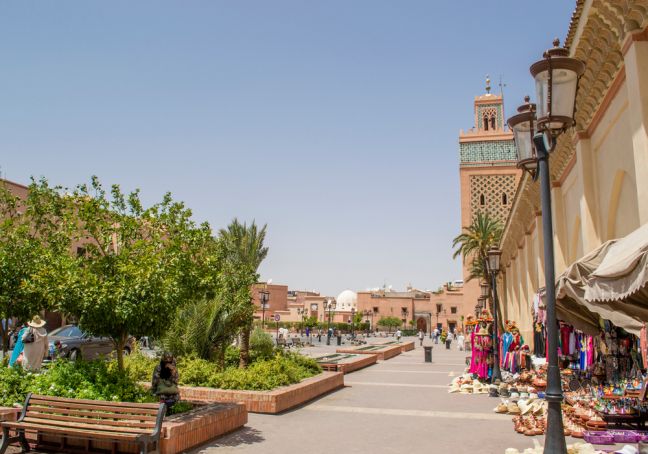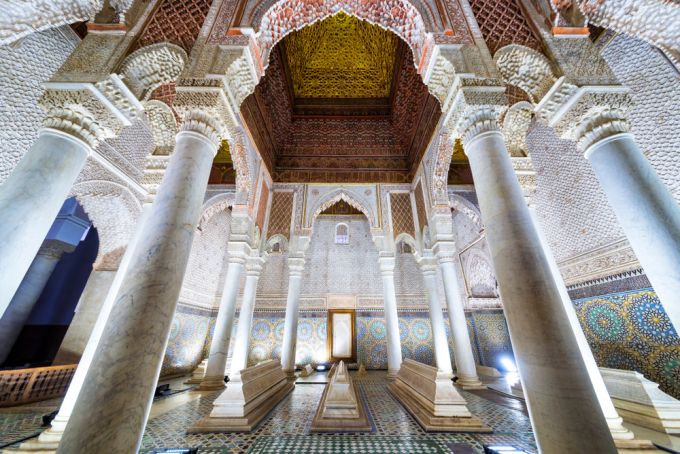Kasbah district
Just south of Marrakesh’s city center is the neighborhood of Kasbah. This laidback district welcomes all through one of the 19 gates of Medina, the Bab Agnaou.
The carved arch was built in the 12th centruy by the Almohad dynasty. Step through the archway on foot or ride through on a carriage to enter Kasbah. Either way, upon leaving the neighborhood of Medina, visitors are able to step away from the influence of the Almohad dynasty and into the Saadian dynasty.
From the 14th to the 16th centruy, Saadian sultans held rule over the city of Marrakesh. Their influence still holds strong in the Kasbah neighborhood and can especially be seen in the districts landmarks, like the Kasbah Mosque and the Saadian Tombs.
The Kasbah Mosque can only be entered by those practicing the Islamic faith. However, despite this restriction for non-Muslims, the Kasbah Mosque is definitely worth a visit. Towering above the mosque are battlements and a stone minaret. Terracotta friezes colored with turquoise decorate the façade. In the lantern, three large brass spheres, commonly called “golden apples,” sit atop the friezes. The Kasbah Mosque is considered to be a model of which all mosques are roughly structured after.
In a close proximity to the Kasbah Mosque, the Saadian Tombs are located in a set of two mausoleums. The magnificent burial ground was dedicated to the entombment of sultans. Despite previously being a burial ground for common people, the Saadian dynasty was able to create a royal place for their deceased. Built from Italian marble and gold and decorated with intricate tile work, the Saadian Tombs and their surrounding gardens are an eye-catching experience for all to see. However, the Saadian Tombs are not easy to find, but they can be located on Rue de la Kasbah.
Saadian Tombs. Ph: Francesco Dazzi / Shutterstock.com
The El Badii Palace, like the Saadian Tombs, is another landmark left for Kasbah by the Saadian dynasty, specifically Sultan Ahmed el-Mansour. El Badii, meaning the incomparable, was meant to blur the memory of dynasties that had previously ruled over Marrakesh.
Composed of 360 rooms, the palace took 15 years to make, with construction finishing in year 1593. Built with impressive and rich materials, such as gold and onyx, the El Badii Palace can be seen as one display of the best craftsmanship, in the Saadian period. After laying abandoned for years, the grand castle was left to decay. However, visitors can catch glimpses of its former glory among the ruins, especially in the vibrantly colored mosaic floors.
Aside from the precious landmarks that occupy Kasbah, the neighborhood is known for its stork population. Although the majority of the storks migrate to Europe in the summer time, a standing population occupies the crumbling walls of the El Badii Palace.
Here, they make nests and watch over their chicks. On the streets below, shop owners chill outside of their stores, on the narrow streets. They aren’t as aggressive towards the typical passersby, as local vendors do in Medina. The environment of Kasbah offers a relaxing retreat from the disorder that infects the rest of the city.
General Info
View on Map
Kasbah district
Kasbah, Marrakesh 40000, Morocco










